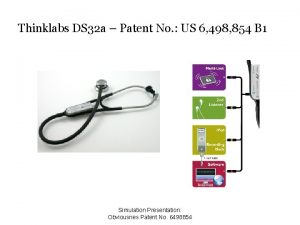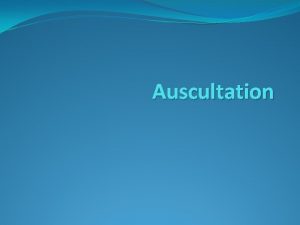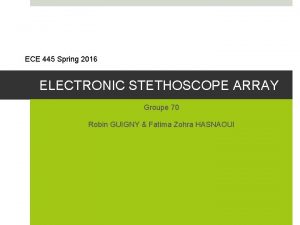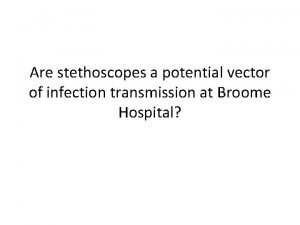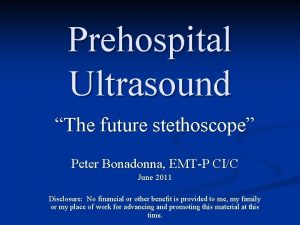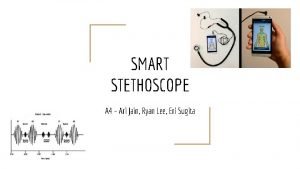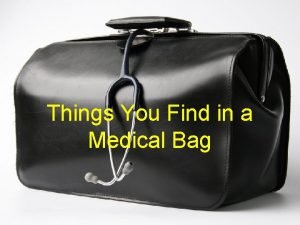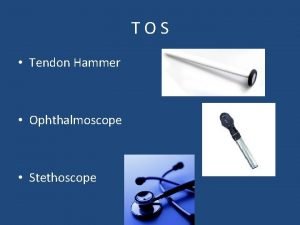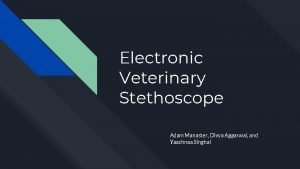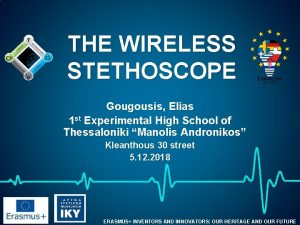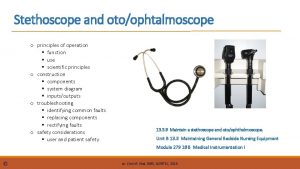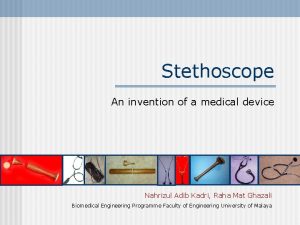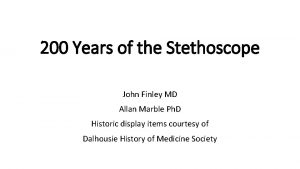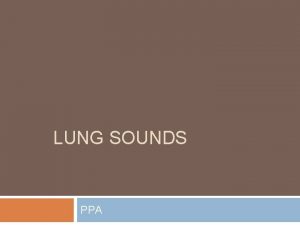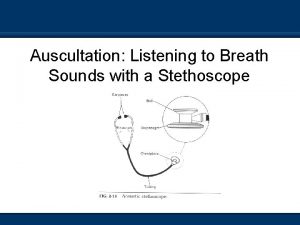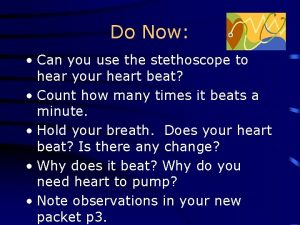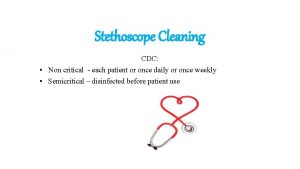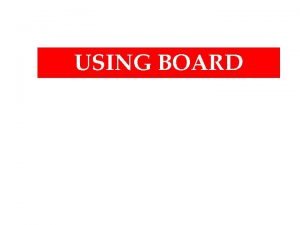An introduction to using the stethoscope History What

































- Slides: 33

An introduction to using the stethoscope • History • What it is • How to care for it • Normal and abnormal breath sounds • Added sounds • Surface marking of the lungs


Immediate auscultation



Stethoscope – what do you hear? • Breath sounds • Added sounds from lung • Added sounds from elsewhere

Stethoscope – what do you hear? Breath sounds • Vesicular • Bronchial May be modified in volume– increased or decreased

Stethoscope – what do you hear? Added sounds from the lungs • Crackles – ‘wet sounds’ [crepitations] • Wheezes – ‘dry sounds’ [rhonchi]

Stethoscope – what do you hear? Added sounds from elsewhere • Pleura – rub [creaky shoe] • Chest wall – fractured rib • Superficial tissues – surgical emphysema • Clothes!!

How do you describe what you hear? • What heard • Where heard • When heard E. g. Inspiratory crackles at the left base

Where do you listen? Over the lungs! Other structures may interfere • Superficial – breast, fat, scapulae • Underlying - liver, heart



Surface anatomy • Vertebra prominens - C 7 • Sternal notch – overlies trachea • Manubrio sternal angle - T 4/5, bifurcation of trachea, 2 nd costal cartilage, upper order of atria, aortic arch • Xiphoid process – T 9













Warning! You cannot tell everything from your stethoscope. The history and other physical signs derived from observation, palpation and percussion are essential to make a diagnosis.






 Peralatan semi kritikal adalah
Peralatan semi kritikal adalah Thinklabs ds32a digital stethoscope
Thinklabs ds32a digital stethoscope Medical term for listening with a stethoscope
Medical term for listening with a stethoscope Electronic stethoscope block diagram
Electronic stethoscope block diagram Stethoscopes hospital hill
Stethoscopes hospital hill Peter bonadonna
Peter bonadonna Hát kết hợp bộ gõ cơ thể
Hát kết hợp bộ gõ cơ thể Frameset trong html5
Frameset trong html5 Bổ thể
Bổ thể Tỉ lệ cơ thể trẻ em
Tỉ lệ cơ thể trẻ em Voi kéo gỗ như thế nào
Voi kéo gỗ như thế nào Thang điểm glasgow
Thang điểm glasgow Alleluia hat len nguoi oi
Alleluia hat len nguoi oi Các môn thể thao bắt đầu bằng tiếng chạy
Các môn thể thao bắt đầu bằng tiếng chạy Thế nào là hệ số cao nhất
Thế nào là hệ số cao nhất Các châu lục và đại dương trên thế giới
Các châu lục và đại dương trên thế giới Công thức tính thế năng
Công thức tính thế năng Trời xanh đây là của chúng ta thể thơ
Trời xanh đây là của chúng ta thể thơ Cách giải mật thư tọa độ
Cách giải mật thư tọa độ Phép trừ bù
Phép trừ bù độ dài liên kết
độ dài liên kết Các châu lục và đại dương trên thế giới
Các châu lục và đại dương trên thế giới Thể thơ truyền thống
Thể thơ truyền thống Quá trình desamine hóa có thể tạo ra
Quá trình desamine hóa có thể tạo ra Một số thể thơ truyền thống
Một số thể thơ truyền thống Cái miệng nó xinh thế
Cái miệng nó xinh thế Vẽ hình chiếu vuông góc của vật thể sau
Vẽ hình chiếu vuông góc của vật thể sau Thế nào là sự mỏi cơ
Thế nào là sự mỏi cơ đặc điểm cơ thể của người tối cổ
đặc điểm cơ thể của người tối cổ Giọng cùng tên là
Giọng cùng tên là Vẽ hình chiếu đứng bằng cạnh của vật thể
Vẽ hình chiếu đứng bằng cạnh của vật thể Tia chieu sa te
Tia chieu sa te Thẻ vin
Thẻ vin đại từ thay thế
đại từ thay thế

